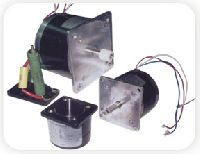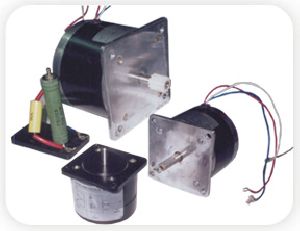
reversible synchronous motors
Instant start, stop & reversible. Low speed 60 RPM @ 50 Hz. Torque from 2 kg.cm to 60 kg.cm (10 models). Insulation Class-B. starting, running & stalling currents are same. Magnetically rotor can be locked by D.C. applying. Power coated cast aluminum body with steel shaft.
...more
Plastic Moulded Gears
Vishal introduces (Acetal copolymer resin-like delrin) white plastic moulded 20 DP gears range. This is very strong material and requires no lubrication for gears. STANDARD GEARS : Gears with 12, 16, 20 and 24 teeths are available without center aluminum bush but with 3/8 dia. D slot. Available with 24, 30, 36. 40, 48, 64, 80, 96,108 and 180 teeth & have center aluminum bush with 3/8" hole with 3 nos. screws / tapped holes provided for easy mounting. COMPOUND GEAR : (Gear / pinion assembly single piece moulded) are available with following gear ratio... 1) 1:2 ---- 20 x 40 teeths 2) 1:3 ---- 16 x 48 teeths 3) 1:4 ---- 12 x 48 teeths 4) 1:1.875 16 x 30 teeths These simple and compound gears can be used in special purpose machines and are available ex-stock or within 1 to 2 weeks. It can also be coupled with 'vishal-syn' A.C. Synchronous motors or D.C. stepping motors or PMDC geared motors. For bulk requirement we can develop moulded gears with other module / D.P. or teeth as per your specific requirements and drawing.
...more
GEARED SYNCHRONOUS
"Vishal" Geared motor are available with two types of gearboxes. 1) Synchronous or Stepper motor frame size 2.3" (motor dia. 58mm) is coupled with 80 x 73 x 17 mm gearbox. 2) Synchronous or Stepper motor frame size 3.4" & 4.2" (motor dia. 86mm & 108mm) is coupled with cast aluminum gearbox.
...more
dc stepper motor
Stepping motor is an electromagnetic device which converts digital pulses into discrete mechanical rotational movements. The motors are hybrid type unipolar or bipolar having multi- toothed rotor & stator. The rotor uses permanent magnet & the stator is two phase pair (four phase) bifilar winding, with 6 leads or 8 leads. STEPPING MOTOR WORKING : The stepping action of motor shaft is caused by sequential switching of supply to the two phase pair of motor as shown in full step & half step logic sequence table. Motor direction can be changed either by reversing logic sequence direction or by interchanging connection of any one phase pair. SPECIAL FEATURES : 1) A wide range of rotating speeds (stepping rate) proportional to the frequency of the pulse signal is provided. 2) The rotating angle of the motor is directly proportional to the number of input pulses. 3) The angle error per step is very small & non-cumulative. 4) Rapid response to starting / stopping & reversing. 5) Digital input pulse signal provide open-loop control, thus making the system simple & avoiding the need for closed loop system for less critical application. 6) Self-holding capability makes it possible for the rotor to be held in the stepped position without the use of brakes. TERMINOLOGY : 1) Torque-Speed curve 2) Holding Torque : It is the maximum torque require to change the step angle, When the stator winding is in exciting state at the rated voltage. 3) Detent Torque : Torque created on the output shaft of a motor, when stator is in no exciting state & whose rotor uses permanent magnet. 4) Step Angle : The nominal angle through which the shaft of a stepping motor turns in response to one pulse signal. 5) Start-Stop Region : The region, in which a stepping motor can start, stop or reverse in synchronism with the external pulse signal. 6) Slew Range : In the region above the start-stop region, a stepping motor can respond without loss of synchronism, even when there is a gradual increase in the frequency or the torque load within this region. 7) Pull-in Torque : The max. torque at which an energized stepping motor will start and run in synchronism in the start-stop region. 8) Pull-out Torque : The max. torque which can be applied to the shaft of a stepping motor without loss of synchronism, even when there is a gradual increase in frequency or load torque within the slew range. 9) Resonance : When a motor is operated at its natural frequency, typically 90 to 180 pps or sometimes in the higher frequency region, suddenly an increase in the audio and vibration depending on motor model selected. In some cases motor will reverse or miss-step also. 10) Acceleration and Deceleration (Ramping ) : In most cases, a stepping motor cannot achieve high speeds immediately when started and will overshoot if not decelerated from these speeds. Therefore, acceleration and deceleration, or "ramping" as it is commonly known, must be provided to assure realiable stepping and maintain positioning accuracy in the slew range region.
Phase : Two phase pair (four phase)
Dielectric Strength : 500V A.C. for 1 Minute
Iec Frame Sizes : 58 mm, 86 mm & 108 mm
...more
Ac Synchronous Motor
'Vishal SYN' Reversible A.C. Syn. motors are Ungeared low speed 60 RPM @ 50Hz. & offering large torque range from 2kg-cm to 60 kg-cm in three NEMA frame sizes viz. O.D. 2.3. " (58 mm), 3.4 " (86 mm) & 4.2" (108 mm) and in 10 different models. The motor consist of 3 lead two phase wound stator & permanent magnet rotor. FEATURES Instant start, stop & reversible. Low speed 60 RPM @ 50 Hz. Torque from 2 kg.cm to 60 kg.cm (10 models). Insulation Class-B. starting, running & stalling currents are same. Magnetically rotor can be locked by D.C. applying. Power coated cast aluminum body with steel shaft. CHARACTERISTICS 1) A.C. Operation : motor can be directly connected to 240 V;50Hz, supply along with factory supplied R-C network in series with one of the stator winding. Change of this R-C network from one winding to other results reversal of motor direction. Single pole three position switch can be used for Forward, Reverse & Off control as shown in the following diagram. Metal varistor oxide may be used to minimize the switch contact arcing. 2) Starting : Motor start within 1 1/2 Cycles of its applied frequency & will reach 60 RPM within 5 to 30 mS at 50 Hz. Since motor has no significant current rise on starting, this motor is ideal to an application which requires six or more starts per minute. 3) Stalling : Motor will not be overheated if stalled because starting, full load and no load currents are same. However prolonged operation against a solid stop will eventually produce bearing failure due to the resultant shaft vibrations. 4) Inertia Limitations : Since the motors are having extremely rapid starting, there is a limit to the inertia load at which the motor will start from rest. Addition of resilient coupling with app. 5 degree of rotational freedom or gearing with backlash between motor & load can increase the permissible inertia load handing capability. 5) Phase Shift Network : The values of R-C network have considerable effect on motor performance. They have been chosen by 'Vishal' in such a manner that no reverse torque is produced when voltage is applied. R-C values should not be varied more than 5% so as to enhance smoother starting, give quieter operation, maximize torque & improve efficiency.Other values may be recommended by the factory for the continuous duty specific OEM application 6) Stopping & Holding (Braking) : Due to magnetic rotor, these motors decelerate faster than conventional motors & stop within 5 degree after turnoff with no external inertia. Application of D.C. supply to one or both motor windings after removal of A.C. supply results deceleration time 1/10th to 1/20th those available with conventional motor & the motor shaft is electrically locked after the stop. A typical circuit for applying, stopping & or holding current is shown in the following diagram. 7) Back Driving : These motors act as generators when back driven. Rotating in access of 1400 RPM is not recommended because high voltages can be generated. At 1400 RPM or below suitable precautions for protection of personnel/phase shift capacitor & any other connected circuitry may be necessary when back driving. 8) 60 Hz Operation : These motors may be operated on 60 Hz, but may require a different R-C network, the factory must be consulted. Torque rating should be similar to those shown for 50Hz & speed is 72 RPM @ 60 Hz.
...moreBe first to Rate
Rate ThisOpening Hours